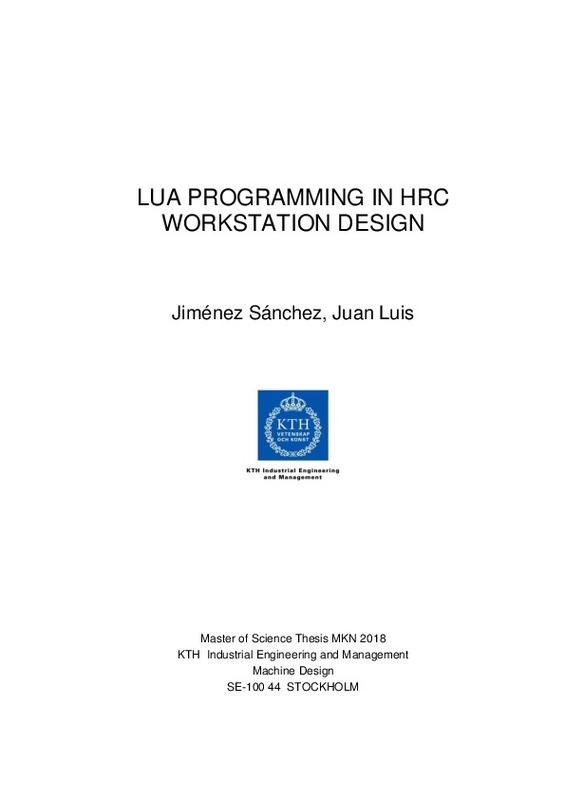JavaScript is disabled for your browser. Some features of this site may not work without it.
Buscar en RiuNet
Listar
Mi cuenta
Estadísticas
Ayuda RiuNet
Admin. UPV
Programación Lua para el diseño de estaciones de trabajo HRC
Mostrar el registro sencillo del ítem
Ficheros en el ítem
| dc.contributor.advisor | Valera Fernández, Ángel
|
es_ES |
| dc.contributor.advisor | Xi, Wang
|
es_ES |
| dc.contributor.author | Jiménez Sánchez, Juan Luis
|
es_ES |
| dc.date.accessioned | 2020-05-11T08:15:22Z | |
| dc.date.available | 2020-05-11T08:15:22Z | |
| dc.date.created | 2018-09-20 | |
| dc.date.issued | 2020-05-11 | es_ES |
| dc.identifier.uri | http://hdl.handle.net/10251/142918 | |
| dc.description.abstract | [EN] One approach to address the future challenges of an increasingly global market’s competition and the demographic changes of an aging workforce for manufacturing companies in developed countries is the close collaboration between human operators and industrial robots. These humanrobot collaborative (HRC) assembly systems aim to combine the best characteristics of the human; its flexibility, intelligence and tactile sense, with robotic speed, endurance and repeatability. Although currently safety legislation limits the possible collaborative applications that could be implemented in practice, large research efforts are put in order to enable practical implementation of these future workstations. Once these safety legislation limitations have been addressed, a need to simulate these systems before implementing them will arise. Virtual simulations are an important part of modern production system design and will be demanded in future assembly workstation design. A new existing software is in development that can simulate, visualise and evaluate HRC assembly workstations. The general goal with the simulation software is to design “optimal” workstations, and they enable evaluations of multiple design alternatives to reach this “optimum”. The creation of these design alternatives is challenging today as it demands a lot of manual work. The aim of this thesis is to tackle this issue by contributing to the development and improvement of the simulation software through the programming of scripts in the Lua language. The scripts were developed through an iterative and trial-and-error process, combined with first-hand experience of the author in the usage of the software. The resulting scripts enable the user to perform simulations in a swift, efficient, automated and simplified way in comparison to the traditional method, reducing the need of manual work to a minimum. A large amount of simulations can be performed in a short amount of time, even without the need of human interaction. In addition, with the results of the simulations as a base, mathematical optimisation techniques have been employed in order to find the optimal HRC design of a case study station. The case study has been conducted at a workstation in a heavy vehicle manufacturer. The results of the case highlight the improvements made to the software by the scripts and how these can be used to efficiently design the HRC workstations of the future. | es_ES |
| dc.description.abstract | [ES] En este trabajo se utilizará el lenguaje de programación LUA para optimizar un software de simulación experimental (Industrial Path Solutions, IPS) para el diseño de estaciones de trabajo con colaboración entre robots colaborativos y trabajadores (Human-Robot Collaboration). El objetivo de la optimización será automatizar mediante scripts la tarea de probar diferentes diseños para encontrar el diseño óptimo en función de varios parámetros (tiempo de proceso, evaluación ergonómica del trabajador, valoración del diseño mediante el método de Muther para SLP). Una vez el software de simulación sea optimizado, se utilizará en un caso práctico para probar su validez. | es_ES |
| dc.language | Inglés | es_ES |
| dc.publisher | Universitat Politècnica de València | es_ES |
| dc.rights | Reserva de todos los derechos | es_ES |
| dc.subject | Simulación | es_ES |
| dc.subject | Diseño de estaciones de trabajo | es_ES |
| dc.subject | Robots colaborativos | es_ES |
| dc.subject | Ergonomía | es_ES |
| dc.subject | Programación Lua | es_ES |
| dc.subject | Scripts | es_ES |
| dc.subject | HRC | es_ES |
| dc.subject | Simulation | es_ES |
| dc.subject | Workstation design | es_ES |
| dc.subject | Collaborative robots | es_ES |
| dc.subject | Lua programming | es_ES |
| dc.subject | Ergonomics | es_ES |
| dc.subject.classification | INGENIERIA DE SISTEMAS Y AUTOMATICA | es_ES |
| dc.subject.other | Máster Universitario en Ingeniería Industrial-Màster Universitari en Enginyeria Industrial | es_ES |
| dc.title | Programación Lua para el diseño de estaciones de trabajo HRC | es_ES |
| dc.type | Tesis de máster | es_ES |
| dc.rights.accessRights | Abierto | es_ES |
| dc.contributor.affiliation | Universitat Politècnica de València. Departamento de Ingeniería de Sistemas y Automática - Departament d'Enginyeria de Sistemes i Automàtica | es_ES |
| dc.contributor.affiliation | Universitat Politècnica de València. Escuela Técnica Superior de Ingenieros Industriales - Escola Tècnica Superior d'Enginyers Industrials | es_ES |
| dc.description.bibliographicCitation | Jiménez Sánchez, JL. (2018). Programación Lua para el diseño de estaciones de trabajo HRC. http://hdl.handle.net/10251/142918 | es_ES |
| dc.description.accrualMethod | TFGM | es_ES |
| dc.relation.pasarela | TFGM\97300 | es_ES |
Este ítem aparece en la(s) siguiente(s) colección(ones)
-
ETSII - Trabajos académicos [10404]
Escuela Técnica Superior de Ingenieros Industriales






